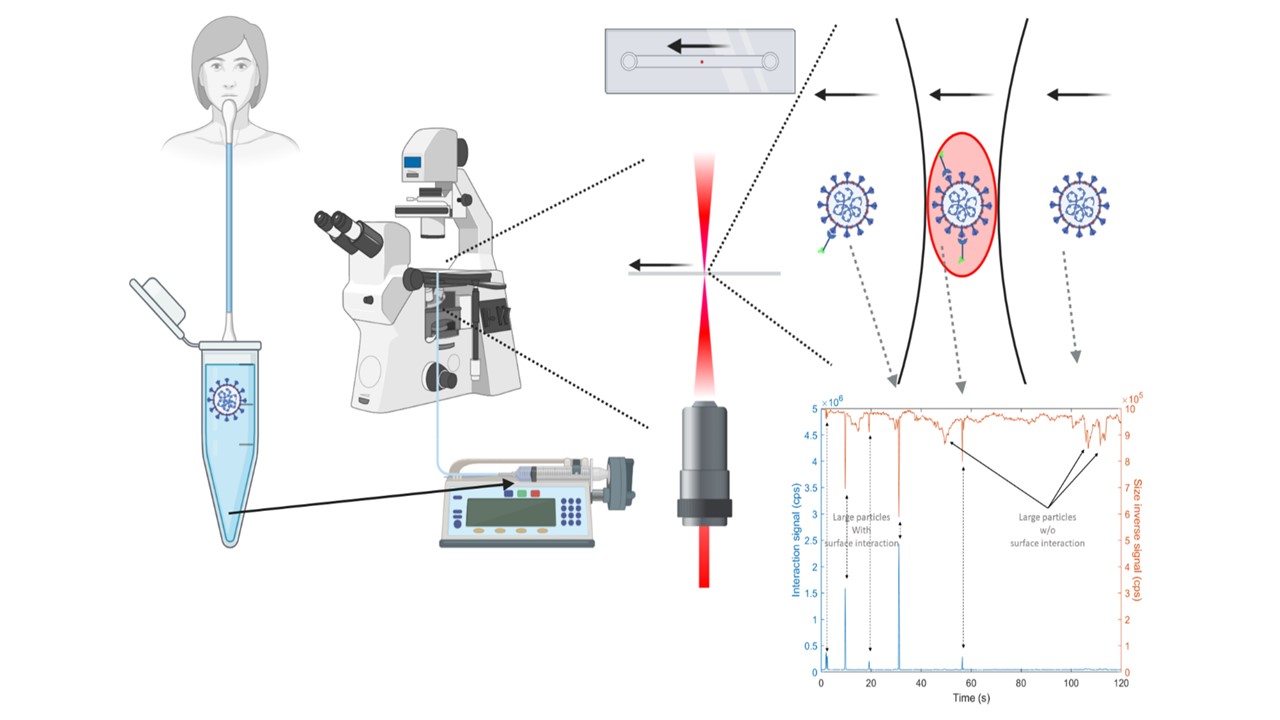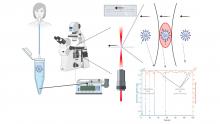Faster assays of COVID-19 bio-detection are important to help the clinic in faster responses accurate management of patients. Mainstream bio-detection of COVID-19 is based on patient saliva or nasal samples and use of RT-PCR. The problem is copies of the viral genome in these samples are found at quite low concentrations (attomolars to femtomolars). The mainstream test requires amplification of the viral genome to reach concentrations giving rise to a detectable signal. This process is slow (a few hours) and laborious.
If one can identify and count single viral particles with high degree of confidence, without the amplification step, it would be faster and easier. By that, one would use the viral version of a well-known apparatus, a flow cytometer, we dub a “flow virometer”.
This is exactly what we are working on. We developed an assay that identifies COVID-19-like particles, based on a coincident detection of two of its specific signatures: size (volume) and protein content of their envelope.
Figure 1: illustration of the flow virometer concept: when the large viral particle passes through a focused laser beam (large compared to the size of the laser focus), it affects both the number of red dyes in the focus (proportion to the signal) and introduces fluorescence signals arising from binding of a fluorescently-labeled antibody specific to the spike protein (capsid specificity). Coincident detection of both is counted as one virus detection. Bottom-right: detection of virus-like particles. Orange trace reports a signal proportional to the size of the particle. Blue trace reports a signal proportional to the amount of probes interacting with envelope proteins.
We are now using this bio-detection module with a microfluidic channel, to produce a flow virometer, with high specificity to SARS-CoV-2. Next, we will test the idea on viral systems safer than SARS-CoV-2, that express the capsid proteins of SARS-CoV-2. This next step is in collaboration with Dr. Alex Rouvinski, Dr. Reuven Wiener, Prof. Moshe Kotler & Prof. Dana Wolf, from the Hadassah Ein Kerem medical campus.
To take the idea to the clinic, our collaborators at LMU, Germany, in the laboratory of Dr. Thorben Cordes, will develop a DIY kit to build a simple flow virometer, deployable in a virology lab or at the clinic.
I would like to thank the Lerner lab crew (Dr. Yair Razvag & Mrs. Paz Drori) for the intense work in the midst of the coronavirus lockdown. I would like to thank Dr. Thorben Cordes from LMU for continuing our long-term collaboration and directing it towards solutions for the current crisis. We thank Dr. Netanel Tzarum & Dr. Ariel Verman (Prof. Belkin lab) for fruitful discussions. We would also like to thank The Milner Foundation for supporting this work.
This research was supported by the ISRAEL SCIENCE FOUNDATION (grant No. 3565/20) within the KillCorona – Curbing Coronavirus Research Program

